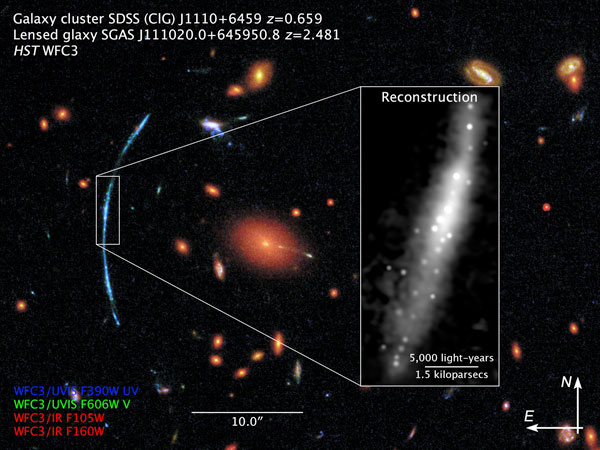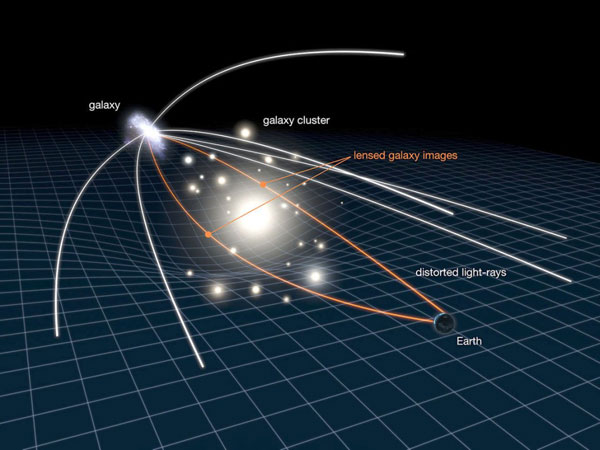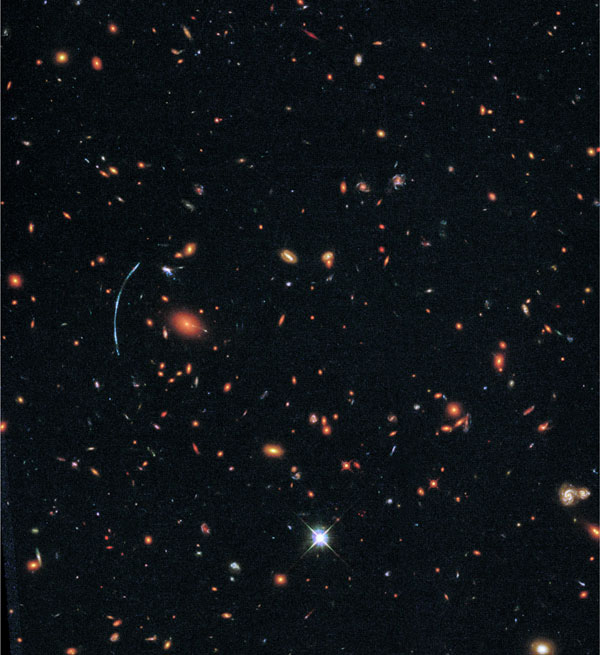Thanks to the effects of gravitational lensing, a team of astronomers was able to reconstruct a distant galaxy and study its unexpectedly clumpy star forming regions.

NASA, ESA, and T. Johnson (University of Michigan)
A team of astronomers, led by Traci Johnson (University of Michigan) and Jane Rigby (NASA Goddard Space Flight Center), has resolved star formation down to 100 light-year scales in the gravitationally lensed galaxy dubbed SGAS J111020.0+645950.8 (SGAS 1110 for short). Usually, Hubble can only resolve structures down to 3,000 light-years across, but a cosmic helping hand known as a gravitational lens sharpened Hubble’s view, magnifying the distant galaxy’s light by about 30 times.

When a massive object, such as a galaxy cluster, lies between a background object and an observer, it acts as a gravitational lens. Its mass bends the spacetime around it, so light from a background object, which would normally disperse outward along straight lines, instead takes a bent path. The lens focuses and magnifies the galaxy’s image, albeit imperfectly — often multiple images appear, and the images are frequently distorted into arcs or, more rarely, positioned around the lens in a so-called Einstein Cross.
In this case, the light from galaxy SGAS 1110 had been traveling for 5 billion years when it bent around a massive galaxy cluster, before traveling another 6 billion years toward Earth.

NASA, ESA, and T. Johnson (University of Michigan)
Using a computer model, the team mapped the magnified, distorted image to reconstruct its original, un-lensed form. The results enabled the team to study the clumpy star formation in the galaxy. They compared the reconstructed image with a model of what the same galaxy would look like without gravitational lensing. A Hubble image of an unlensed galaxy at this distance would appear smooth, as though all its stars were forming in a single disk.
However, with the magnification and higher resolution, the team was able to determine that much of the star formation happens in about two-dozen clumps, each spanning 100 to 150 light-years, along the nearly 23,000-light-year length of the galaxy. This higher resolution has never before been achieved for galaxies observed at that distance.
The studies of this galaxy suggest that we may be able to create a model from this result to predict what unlensed galaxies at the distance of SGAS 1110 look like at SGAS 1110’s higher resolution. Star formation in the early universe could be a whole lot clumpier than we thought.
You can read the entire Hubble press release from July 6, 2017.
 2
2









Comments
July 16, 2017 at 3:46 pm
Is there a reason why the galaxy arc is so blue compared to most of the other galaxies in the frame? As it's (obviously) further away, I'd expect it to show a greater red shift. Is there some subtle relativistic effect of the gravitation field causing the distortion, or is it something else?
You must be logged in to post a comment.
Monica Young
July 17, 2017 at 10:10 am
Hi, Quentin: At a redshift of z=2.5, the galaxy's light is shifted by a factor of 3.5. The light from star formation peaks in the ultraviolet, which has here been shifted to the blue end of the visible spectrum. The galaxy would have to be a lot farther away to be shifted all the way to the red end of the visible spectrum. Hubble has spotted galaxies out to redshifts approaching z=11 (although, unlike this galaxy, those very distant galaxies are just blobs to Hubble — it can't resolve star formation areas at that distance).
You must be logged in to post a comment.
You must be logged in to post a comment.